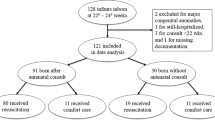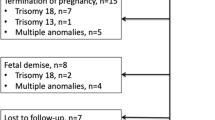Abstract
In our response to, “Parental request for non-resuscitation in fetal myelomeningocele repair: an analysis of the novel ethical tensions in fetal intervention” by Wolfe and co-authors, we argue that parental authority should guide resuscitation decision-making for a fetus at risk for preterm delivery as a complication of fetal myelomeningocele (fMMC) repair. Due to the elevated morbidity and mortality risks of combined myelomeningocele, extreme prematurity, and fetal hypoxia, parents’ values regarding the acceptability of possible outcomes should be elicited and their preferences honored. Ethical decision-making in these situations must also consider the broader context of the fetal-maternal dyad. Innovations in fetoscopic approaches to fMMC repair may pose additional complexity to these resuscitation decisions.
This is a preview of subscription content, access via your institution
Access options
Subscribe to this journal
Receive 12 print issues and online access
$259.00 per year
only $21.58 per issue
Buy this article
- Purchase on Springer Link
- Instant access to full article PDF
Prices may be subject to local taxes which are calculated during checkout

Similar content being viewed by others
References
Wolfe ID, Lillegard JB, Carter BS. Parental request for non-resuscitation in fetal myelomengocele repair: an analysis of the novel ethical tensions in fetal intervention. J. Perinatol. 2022. In press.
Hart AR, Vasudevan C, Griffiths PD, Foulds N, Piercy H, de Lacy P, et al. Antenatal counselling for prospective parents whose fetus has a neurological anomaly: part 2, risks of adverse outcome in common anomalies. Dev Med Child Neurol. 2022;64:23–39. https://doi.org/10.1111/dmcn.15043
AlRefai, A, Drake, J, Kulkarni, AV, Connor, KL, Shannon, P, Toi, A, et al. Fetal myelomeningocele surgery: only treating the tip of the iceberg. Prenatal Diagn. 2018: pd.5390. https://doi.org/10.1002/pd.5390
Boyd PA, Devigan C, Khoshnood B, Loane M, Garne E, Dolk H, EUROCAT Working Group. Survey of prenatal screening policies in Europe for structural malformations and chromosome anomalies, and their impact on detection and termination rates for neural tube defects and Down’s syndrome. BJOG. 2008;115:689–96. https://doi.org/10.1111/j.1471-0528.2008.01700.x
Cummings J, Committee on Fetus and Newborn. Antenatal counseling regarding resuscitation and intensive care before 25 weeks of gestation. Pediatrics. 2015;136:588–95. https://doi.org/10.1542/peds.2015-2336
Stoll BJ, Hansen NI, Bell EF, Shankaran S, Laptook AR, Walsh MC. et al. Eunice Kennedy Shriver National Institute of Child Health and Human Development Neonatal Research Network. Neonatal outcomes of extremely preterm infants from the NICHD Neonatal Research Network. Pediatrics. 2010;126:443–56. https://doi.org/10.1542/peds.2009-2959.
Meadow W, Meadow X, Tanz RR, Lagatta J, Lantos J. The value of a trial of therapy - football as a “proof-of-concept”. Acta Paediatr. 2011;100:167–9. https://doi.org/10.1111/j.1651-2227.2010.02113.x
Singh D, Rath GP, Dash HH, Bithal PK. Anesthetic concerns and perioperative complications in repair of myelomeningocele: a retrospective review of 135 cases. J Neurosurg Anesthesiol. 2010;22:11–15. https://doi.org/10.1097/ANA.0b013e3181bb44a9
Shane AL, Hansen NI, Moallem M, et al. Surgery-associated infections among infants born extremely preterm. J Pediatr. 2022;240:58–65.e6 https://doi.org/10.1016/j.jpeds.2021.08.064.
McPherson C, Grunau RE. Neonatal pain control and neurologic effects of anesthetics and sedatives in preterm infants. Clin Perinatol. 2014;41:209–27. https://doi.org/10.1016/j.clp.2013.10.002
Olutoye OA, Baker BW, Belfort MA, Olutoye OO. Food and Drug Administration warning on anesthesia and brain development: implications for obstetric and fetal surgery. Am J Obstet Gynecol. 2018;218:98–102. https://doi.org/10.1016/j.ajog.2017.08.107
Walden RV, Taylor SC, Hansen NI, Poole WK, Stoll BJ, Abuelo D, et al. National Institute of Child Health and Human Development Neonatal Research Network. Major congenital anomalies place extremely low birth weight infants at higher risk for poor growth and developmental outcomes. Pediatrics. 2007;120:e1512–1519. https://doi.org/10.1542/peds.2007-0354.
Adzick NS, Thom EA, Spong CY, Brock JW, Burrows PK, Johnson MP, et al. MOMS Investigators A randomized trial of prenatal versus postnatal repair of myelomeningocele. N Engl J Med. 2011;364:993–1004. https://doi.org/10.1056/NEJMoa1014379.
Hoagland MA, Chatterjee D. Anesthesia for fetal surgery. Paediatr Anaesth. 2017;27:346–57. https://doi.org/10.1111/pan.13109
Soraisham AS, Lodha AK, Singhal N, Aziz K, Yang J, Lee SK, et al. Canadian Neonatal Network. Neonatal outcomes following extensive cardiopulmonary resuscitation in the delivery room for infants born at less than 33 weeks gestational age. Resuscitation. 2014;85:238–43. https://doi.org/10.1016/j.resuscitation.2013.10.016.
Fraga MV, Giaccone A, Adzick NS. Respiratory morbidities in late preterm and term infants with myelomeningocele. J Perinatol. 2018;38:1542–7. https://doi.org/10.1038/s41372-018-0210-z
Verweij EJ, de Vries MC, Oldekamp EJ, Eggink AJ, Oepkes D, Slaghekke F, et al. Fetoscopic myelomeningocoele closure: Is the scientific evidence enough to challenge the gold standard for prenatal surgery? Prenat Diagn. 2021;41:949–56. https://doi.org/10.1002/pd.5940
Belfort MA, Whitehead WE, Shamshirsaz AA, Bateni ZH, Olutoye OO, Olutoye OA, et al. Fetoscopic open neural tube defect repair: development and refinement of a two-port, carbon dioxide insufflation technique. Obstet Gynecol. 2017;129:734–43. https://doi.org/10.1097/AOG.0000000000001941
Ross LF. Reflections on Charlie Gard and the best interests standard from both sides of the Atlantic Ocean. Pediatrics. 2020;146:S60–S65. https://doi.org/10.1542/peds.2020-0818L
TL Beauchamps, JF Childress. Nonmaleficience: principles of biomedical ethics. New York: Oxford University Press; 2001. 113–64.
Singh J, Lantos J, Meadow W. End-of-life after birth: death and dying in a neonatal intensive care unit. Pediatrics. 2004;114:1620–6. https://doi.org/10.1542/peds.2004-0447
Duff RS, Campbell AG. Moral and ethical dilemmas in the special-care nursery. N Engl J Med. 1973;289:890–4. https://doi.org/10.1056/NEJM197310252891705
Kon AA, Davidson JE, Morrison W, Danis M, White DB. Shared decision making in ICUs: an American College of Critical Care Medicine and American Thoracic Society Policy Statement. Crit Care Med. 2016;44:188–201. https://doi.org/10.1097/CCM.0000000000001396
Crombag N, Sacco A, Stocks B, De Vloo P, Merwe J, Gallagher K, et al. ‘We did everything we could’– a qualitative study exploring the acceptability of maternal‐fetal surgery for spina bifida to parents. Prenat Diagn. 2021;41:910–21. https://doi.org/10.1002/pd.5996
Fry JT, Frader JE. “We want to do everything”: how parents represent their experiences with maternal-fetal surgery online. J Perinatol. 2018;38:226–32. https://doi.org/10.1038/s41372-017-0040-4
Chervenak FA, McCullough LB. A comprehensive ethical framework for fetal research and its application to fetal surgery for spina bifida. Am J Obstet Gynecol. 2002;187:10–14. https://doi.org/10.1067/mob.2002.124274
Mattingly SS. The maternal-fetal dyad exploring the two-patient obstetric model. Hastings Cent Rep. 1992;22:13 https://doi.org/10.2307/3562716
Begović D. Maternal-fetal surgery: does recognising fetal patienthood pose a threat to pregnant women’s autonomy? Health Care Anal. 2021;29:301–18. https://doi.org/10.1007/s10728-021-00440-2
Author information
Authors and Affiliations
Contributions
SKK conceptualized the manuscript, co-wrote the initial draft, and revised the manuscript. JTF made substantial contributions to conceptualizing the manuscript, co-wrote the initial draft, and revised the manuscript.
Corresponding author
Ethics declarations
Competing interests
The authors declare no competing interests.
Additional information
Publisher’s note Springer Nature remains neutral with regard to jurisdictional claims in published maps and institutional affiliations.
Rights and permissions
About this article
Cite this article
Kukora, S.K., Fry, J.T. Resuscitation decisions in fetal myelomeningocele repair should center on parents’ values: a counter analysis. J Perinatol 42, 971–975 (2022). https://doi.org/10.1038/s41372-022-01385-7
Received:
Revised:
Accepted:
Published:
Issue Date:
DOI: https://doi.org/10.1038/s41372-022-01385-7



